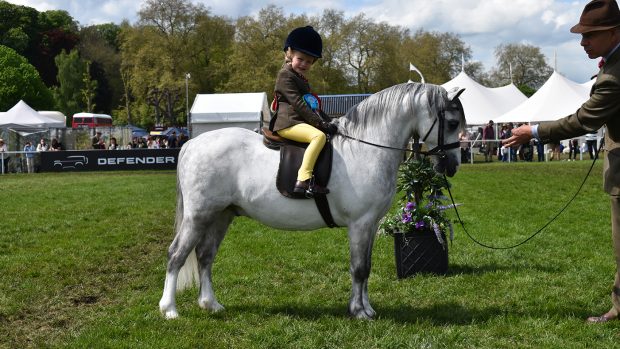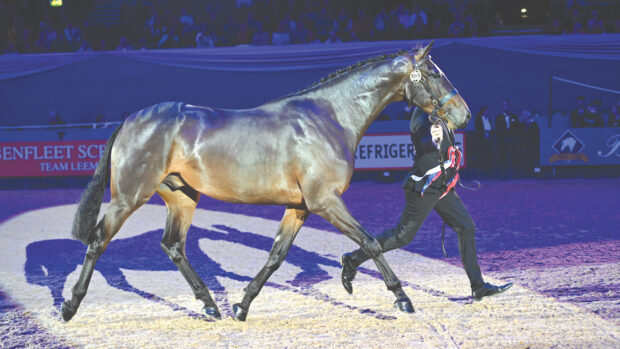If you’re gearing up for the 2021 term with your traditional, hogged or native coloured, read H&H’s guide to preparing your horse or pony and hitting the right notes once you’re in the ring.
The following expert insight will help you create the best possible picture and increase your chance of taking home a red rosette:
Class options
The ‘hairy’ classes for coloured show animals are made up of native, cob, traditional and vanner types. The ridden classes are split into two: ponies not exceeding 148cm and horses exceeding 148cm.
There are two societies governing the coloured horses in the UK:
The Coloured Horse and Pony Society (CHAPS)
The British Piebald and Skewbald Society (BSPA)
You must be a member of CHAPS to contend Horse of the Year Show (HOYS) classes and BSPA to qualify and compete at the Royal International (RIHS).
The TGCA (Traditional Gypsy Cob Association) Ltd is a society for the traditional gypsy cob, which many traditional coloureds might also fall under.
Not sure if your cob is a coloured? Check out the description of a coloured horse or pony here.
Performance
In horse classes, the performance judge will ride each horse while in pony classes the performance judge will ask each exhibit to perform an individual show either set by the judge or chosen by the rider.
Turnout
Traditional gypsy cobs are judged using the same criteria and conformation rules as any other show class, but are shown in a natural state with a full mane and tail as well as full feathers. Cobs are hogged and natives are subject to some trimming and clipping of the mane and tail.
Feathers
“The care of hair and feathers in traditionals’ is crucial,” explains CHAPS and BSPA judge Liz Wright. “My traditionals are regularly treated with pig oil to keep their hair in good condition. This works as a barrier against water and mud, and the addition of sulphur powder in pig oil helps to keep the dreaded feather mites at bay.
“It’s an old fashioned remedy but used regularly it works very well. Jabs from the vet containing ivermectin seem to work incredibly well on some, but not all. I tend to use blue whitening shampoos and always condition manes, tails and feathers.
“Feathers should be full, ideally coming from the front of the cannon as well as the back and should cover the hoof. Fine, silky straight feather is more desirable than coarse, curly feather.
White patches
To make lighter patches gleam you should…
- Keep on top of stains daily.
Remove them as soon you see them as an ingrained stain is very hard to remove. A good quality purple shampoo is essential, but do not leave it on too long.
“I find mixing chalk powder with a little water to make a loose paste and applied the night before works well,” says show producer Natalie Reynolds. “It’s then brushed over in the morning to remove excess and can work wonders to achieving extra whiteness and reduce staining.”
- Keep animals plaited.
“I like to keep manes and tails loosely plaited,” says Liz. “And in some cases, containing them in mane and tail bags can help reduce staining.”
- Chalk block.
“A chalk block on the day can help with any last minute touch ups. But always bath your horse afterwards to remove any product you apply on show days,” advises Natalie.
- Cover them up.
“I’m not a fan of bandaging because I hate to see the dreadful lines and wrinkled skin that over-bandaging can cause,” states Natalie. “Hoods and a well fitting rug with a neck cover can help keep them clean the night before a show.”
- Accept they will get dirty!
“I’m all for letting horses be horses and I don’t like to think of some of the traditionals not being allowed to get dirty,” concludes Natalie. “Keeping a coloured horse clean isn’t easy and I find they stain worse than greys.”
Correct way of going
“It gives me great pleasure to see the popularity of the traditional Gypsy cob,” says Liz. “They are usually straightforward and easy to ride, which makes them suitable for most riders, including novices. When I was a child a coloured cob was really looked down upon, but fortunately they’re not any longer.”
In the ring, a traditional coloured should work forward.
“When under saddle traditionals should go forward using their hocks well, in a mannerly and workmanlike way. They should display a genuine, calm temperament,” confirms Liz.
What are the judges looking for?
There is a diverse mix of coloured types.
“As a judge you have to look for the best one that is the most correct for its specific type in the class,” explains CHAPS judge and coloured horse producer Simon Reynolds. “For example, a show cob will have a different action and way of going to a native bred horse, which may have more knee action. They will certainly be different to a vanner, which has a more up/down, workmanlike movement due to them having an upright, straighter shoulder.
“Each horse is judged for what they are and an experienced judge will pick out the best examples of their type.”
Generally, though, the principles of judging coloured natives are the same as for any show class.
“The animal must have correct conformation, be sound of wind and limb, show good movement and be eye catching,” says Simon. “Wall and blue eyes are acceptable and shouldn’t be penalized.”
Simon adds that judges must not be prejudiced about markings. “Sometimes an unevenly marked animal can appear to be short fronted, for example if the splash of colour ends prematurely up its neck. Again, a good judge can see through this. I always ask myself two things: one, ‘if this horse was one solid colour what would it look like, and two, would it be correct?’”
Continued below…
Like this? You might also enjoy reading these:
H&H’s guide to show hunter classes: weight categories, presentation and what makes the judges cringe
H&H’s guide to show cob classes: from weight divisions to showing off correctly
Subscribe to Horse & Hound magazine today – and enjoy unlimited website access all year round
Judges’ pet hates
- Back-combed feathers.
“The feather should lie flat and naturally,” says Natalie. “Back combing would alert me to whether the rider is trying to disguise poor conformation and faults including splints, curbs, bowed tendons or a lack of bone.”
Simons adds: “Quite often it can be a disadvantage to ride a show cob, as all blemishes are on show, whereas hair can often hide a multitude of sins.”
- Excessively long manes and tails.
“This unbalances the overall impression and tails dragging on the ground can be dangerous,” says Liz.
Natalie concurs.
“I can’t bear to see horses standing on their own tails or not being able to see where they are going. Also too much length makes it difficult to see the structure of the horse because they are covered up.”
- Back at the knee.
“This has been an all too common fault, particularly in cobs, but thankfully this seems to be improving all the time,” says Liz.
- Over-bent horses.
“A horse going along with its head jammed in its chest is unable to move properly from behind and is generally uncomfortable and unhappy,” adds Liz.
Liz concludes that there is more to showing traditional coloureds than most people think.
“There is a misconception that showing traditional gypsy cobs is all about hair and colour, which it most certainly is not,” she states. “These animals must have correct conformation, movement and manners just like any other show horse, as well as that ‘look at me’ factor.”
Where to compete
All major shows usually include classes for coloured horses and ponies. Normally, the classes will be split (non-native horses, non-native ponies, traditional/native/cob horses and traditional/native ponies).
At smaller shows, there may only be one coloured class, or separate horse and pony coloured classes.
The HOYS CHAPS and the BSPA RIHS classes are of the highest prestige, but there are many opportunities for coloured owners across the board.
The CHAPS and BSPA championships and area shows hold classes for everyone; from first riddens to veterans, from in-hand animals to working hunters.
Would you like to read Horse & Hound’s independent journalism without any adverts? Join Horse & Hound Plus today and you can read all articles on HorseandHound.co.uk completely ad-free






